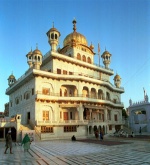Template:AOW44: Difference between revisions
Hari singh (talk | contribs) No edit summary |
Hari singh (talk | contribs) No edit summary |
||
| (13 intermediate revisions by the same user not shown) | |||
| Line 1: | Line 1: | ||
[[Image:Akal-takhat-2.jpg| | {{aowh|[[Akal Takhat]]}} | ||
{{pm|Image:Akal-takhat-2.jpg|'''[[Akal Takhat]]'''}} | |||
'''[[Akal Takhat]]''' ([[Punjabi]]: <big>ਅਕਾਲ ਤਖ਼ਤ</big>) means the ''Throne of the Immortal'' and is historically the highest political institution of the [[Sikh]]s. | |||
"Akal" means ''"The Timeless One"'' - another term for God. "Takhat" means ''"throne"'' in Persian. This is one of a total of [[five takhat of the Sikhs]]. | |||
The [[Akal Takhat]] is an impressive building that sits directly in front of the causeway leading to the [[Golden Temple]] in [[Amritsar]]. | |||
This institution was founded by [[Guru Hargobind]] on [[July 2]], [[1606]] and was established as the place from which the spiritual and temporal ([[Miri Piri]]) concerns of the [[Sikh community]] could be acted upon. | |||
It stood as a symbol of political bulwark against the [[Mughal]] Emperors in the 17th and 18th century. Various attacks on the [[Akal Takhat]] and [[Harmandar Sahib]] have taken place in the past by [[Ahmed Shah Abdali]] and [[Massa Rangar]] in the 18 century. | |||
On [[June 4]], [[1984]], the Indian Army damaged the outer façade of the [[Akal Takhat]] while attempting to flush out Sikh militants in a controversial military operation known as [[Operation Bluestar]]. <!--- | |||
It is the most supreme of all the [[Takhat]]s. There are four other [[takhat]]s established by the panth (community) during the last century: | |||
*[[Keshgarh Sahib]] in [[Anandpur sahib]] | |||
*[[Patna Sahib]] in [[Bihar]] | |||
*[[Hazur Sahib]] in [[Maharashtra]] | |||
*[[Damdama Sahib]] in [[Punjab]] ---> {{Aowf|Akal Takhat}} | |||
Latest revision as of 17:44, 20 June 2012
Akal Takhat (Punjabi: ਅਕਾਲ ਤਖ਼ਤ) means the Throne of the Immortal and is historically the highest political institution of the Sikhs.
"Akal" means "The Timeless One" - another term for God. "Takhat" means "throne" in Persian. This is one of a total of five takhat of the Sikhs.
The Akal Takhat is an impressive building that sits directly in front of the causeway leading to the Golden Temple in Amritsar.
This institution was founded by Guru Hargobind on July 2, 1606 and was established as the place from which the spiritual and temporal (Miri Piri) concerns of the Sikh community could be acted upon.
It stood as a symbol of political bulwark against the Mughal Emperors in the 17th and 18th century. Various attacks on the Akal Takhat and Harmandar Sahib have taken place in the past by Ahmed Shah Abdali and Massa Rangar in the 18 century.
On June 4, 1984, the Indian Army damaged the outer façade of the Akal Takhat while attempting to flush out Sikh militants in a controversial military operation known as Operation Bluestar. .....More

